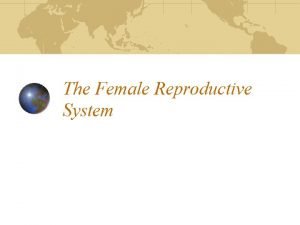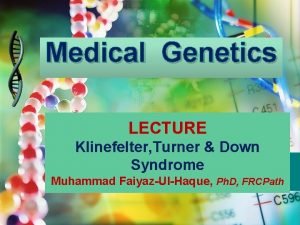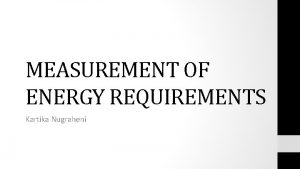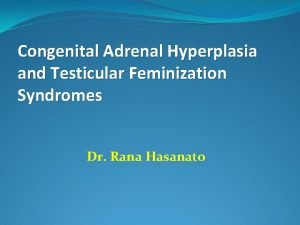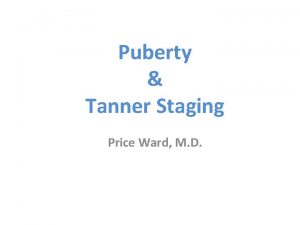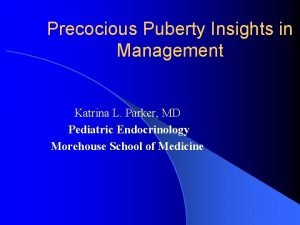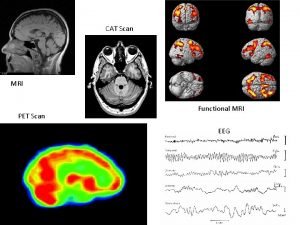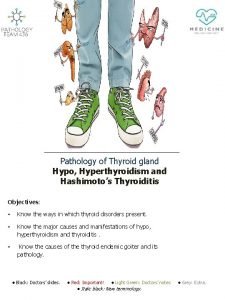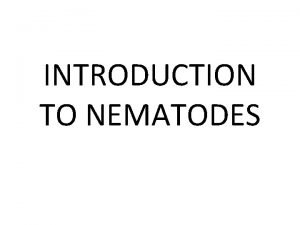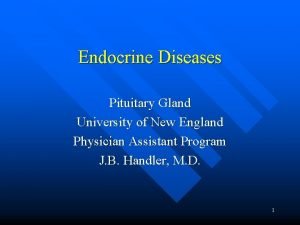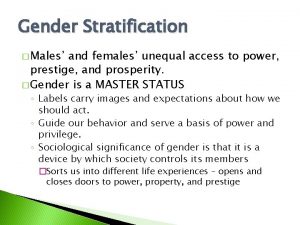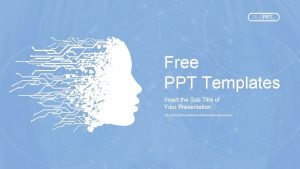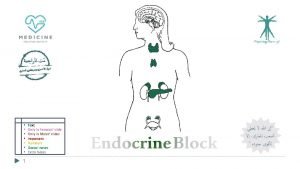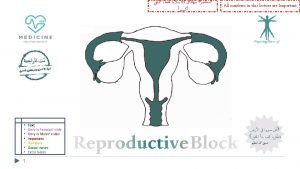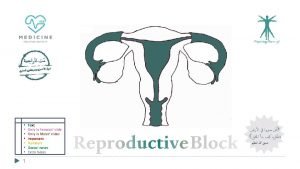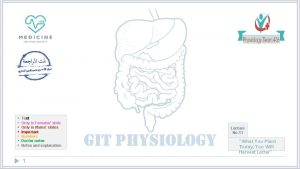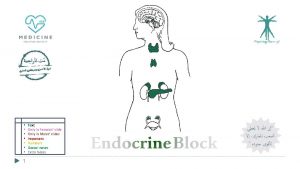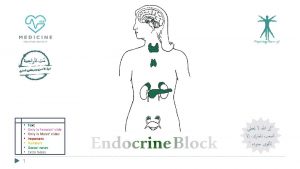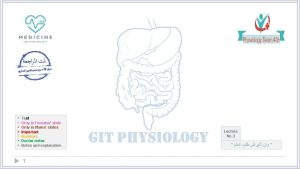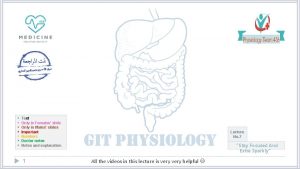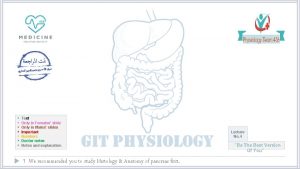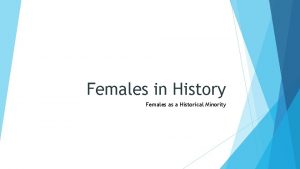1 Text Only in Females slide Only in









































- Slides: 41

ﺍﻛﺴﺘﺮﺍ ﺷﺮﺡ ﺃﻐﻠﺒﻬﺎ ، ﻃﻮﻳﻠﺔ ﻣﻮ ﺍﻟﻤﺤﺎﺿﺮﺓ § § § § 1 Text Only in Females’ slide Only in Males’ slides Important Numbers Doctor notes Extra Notes

Menstrual Cycle (Ovarian & Uterine cycles) By the end of this lecture, students should be able to describe: 1. Recognize the hypothalamic- pituitary-ovarian-axis. 2. Describe the physiological phases of ovarian cycles. 3. Describe the changes that occur in the ovaries leading to ovulation. 4. Describe the development and the fate of corpus luteum. 5. Describe the normal phases of menstrual cycle. 6. Discuss the structural changes that occur in the endometrium during the menstrual cycle and explain how these changes are hormonally controlled. 7. List the hormones of female reproduction and describe their physiological functions. 8. Describe the physiology of menopause and the disorders of menstruation. 2

Physiologic Anatomy of The Female Sexual Organs Since the vagina in the middle between the urethra and the rectum, During delivery they put a catheter to evacuate the urinary bladder for easier delivery + enema to o expel the rectum contents to facelift the delivery. 3 � The picture shows the principal organs of the human female reproductive tract, including the ovaries, fallopian tubes (also called uterine tubes), uterus, and vagina. � Reproduction begins with the development of ova in the ovaries. In the middle of each monthly sexual cycle, a single ovum is expelled from an ovarian follicle into the abdominal cavity near the open fimbriated ends of the two fallopian tubes. � This ovum then passes through one of the fallopian tubes into the uterus; if it has been fertilized by a sperm, it implants in the uterus, where it develops into a fetus, a placenta, and fetal membrane and eventually into a baby.

Layers of Uterine Wall 4 � Uterine wall, which is made up of three different layers. There's the outer perimetrium, the middle (muscular) myometrium (that's the thickest layer), and the inner endometrium (thinner layer). � But only one of these layers undergoes the changes during the uterine cycle, and that's the endometrium. � The endometrial tissue itself is also made up of two layers: 1. Basilar zone, which attaches the endometrium to the underlying myometrium. 2. Functional zone, which is the part that changes throughout the uterine cycle.

Introduction of Female Reproductive Physiology � Monthly ovarian cycle: In normal reproductive years of female there is a monthly rhythmical changes in the rates of secretion of female hormones & corresponding physical changes in the ovaries & other sexual organs (menstrual / sexual cycle). � Duration of the cycle: Duration of the menstrual cycle averages 28 days (20 - 45 days). (menstrual cycle = ovarian cycle + uterine cycle) � Results of the female sexual cycle: (important) 1. Single ovum (oocyte) ﺍﻟﺒﺪﺍﺋﻴﺔ ﺍﻟﺒﻮﻳﻀﺔ is released from the ovaries each month. 2. Uterine endometrium is prepared for implantation of the fertilized ovum (Under the effect of estrogen and secretory changes). 5

Gonadotropic Hormones & Their Effects on The Ovaries Gn. RH 6 � The ovarian changes during the sexual cycle depend completely on FSH & LH secreted by anterior pituitary, controlled by negative feedback. � In the absence of these hormones, the ovaries remain inactive throughout childhood. � At puberty the anterior pituitary starts to secrete FSH & LH which lead to the beginning of monthly reproductive cycles. � First menstrual cycle is called menarche. � Both FSH and LH stimulate their ovarian target cells by combining with highly specific receptors leading to an increase: 1. Rates of secretion. 2. Growth & proliferation of the cells. � Gn. RH released at puberty & stimulates the relapse of FSH and LH which are proteins (peptide hormones) & we cannot measure Gn. RH from blood because its secretion is pulsatile, not sustained. � in females it will affect ovaries only not endometrium or uterus and in males it will affect testis, then it will stimulate the release of progesterone and estrogen in female and testosterone in male and these are steroid hormones so, it can cross BBB. � Oral contraceptives contain estrogen and progesterone. � All hormones cause -ve feedback except oxytocin and estrogen cause both -ve feedback & +ve feedback.

Mnemonic: ü Progesterone pro- means after or extra, so we correlate its function time being after ovulation. ü To memorize the different phases of each cycle remember this sentence: ( FOo. L Many Protective Sloths) (Follicular, Ovulatory, Luteal, Menstrual, Proliferative, secretory) Overview of Menstrual Cycle From day 1 - 14 Day 14 From day 14 - 28 Usually luteal phase is fixed but the follicular may be disturbed and differs from month to another = Follicular phase = Luteal phase ü When we start to count the days of the cycle? when the bleeding starts. ü The menstrual cycle ﺍﻟﺸﻬﺮﻳﺔ ﺍﻟﺪﻭﺭﺓ composed of two cycles: 1. The Ovarian cycle which occurs in the ovaries. ﺍﻟﻤﺒﺎﻳﺾ ﻓﻲ ﺗﺤﺪﺙ ﺗﻐﻴﺮﺍﺕ 2. The Uterine cycle which occurs in the endometrium of the uterus. endometrium ﻟﻠﺮﺣﻢ ﺍﻟﺪﺍﺧﻠﻴﺔ ﺍﻟﻄﺒﻘﺔ ﻓﻲ ﺗﺤﺪﺙ ﺗﻐﻴﺮﺍﺕ 7 . ﻣﺘﺴﻠﺴﻠﺔ ﺟﻤﻴﻌﻬﺎ ﻭﻟﻴﺴﺖ ﻣﺘﺪﺍﺧﻠﺔ Cycles ﻭﺍﻟـ ﺍﻟﺘﻐﻴﺮﺍﺕ ﺃﻦ ﺑﺒﺎﻟﻜﻢ ﺣﻄﻮﺍ : ﺑﺎﻟﺼﻮﺭﺓ ﻣﻮﺿﺢ ﻣﺎﻫﻮ ﻣﺜﻞ (Follicular Phase + proliferative phase + menstrual phse ) ﺍﻟـ . Ovulation ﺍﻟـ ﻳﺤﺪﺙ ﻭﺑﻌﺪﻫﻢ ، ﻭﺍﻟﻨﻬﺎﻳﺔ ﺍﻟﺒﺪﺍﻳﺔ ﺃﻮﻗﺎﺕ ﺍﺧﺘﻼﻑ ﻣﻊ ﺍﻟﻮﻗﺖ ﺑﻨﻔﺲ ﻳﺤﺪﺛﻮﻥ (Luteal phase + secretory phase) ﺍﻟـ ﻭﺑﻌﺪﻫﺎ

Effect of LH & FSH In Biosynthetic Pathway For Progesterone & 17β-estradiol In The Ovaries � What should I memorize from this diagram? 1. Luteinizing hormone (LH) stimulates cholesterol desmolase enzyme in theca cells. Cholesterol desmolase enzyme is the enzyme that converts cholesterol to pregnenolone which is the first step of steroids hormone synthesis. 2. Pregnenolone will be converted into progesterone by 3βhydroxysteroid dehydrogenase. 3. Follicle-stimulating hormone (FSH) stimulates aromatase enzyme in granulosa cells. Aromatase enzyme is the enzyme that converts testosterone to the 7β-estradiol. 8

“Follicular” Phase of The Ovarian Cycle (Ovarian follicle growth) Stage 1 primordial follicle Stage 2 & 3 Primary Follicles Stage 4 Secondary Follicles Stage 5 Mature Graafian Follicles When the follicular phase occur? It occurs 1 - 14 days after the onset of menstruation in 28 days cycle. 9

This slide is only in females but the males Dr talked about it Cont. Stage 1: Primordial Follicle � In female child each ovum (oocyte) is surrounded by single granulosa cell sheath called primordial follicle. Ovum (oocyte) = ﻟﻠﺒﻮﻳﻀﺔ ﺍﻟﺒﺪﺍﺋﻴﺔ ﺍﻟﺼﻴﻐﺔ � Functions of granulosa cells during childhood: (Important) 1. Provide nourishment ﺍﻟﻐﺬﺍﺀ for the ovum. 2. Secrete oocyte maturation inhibiting factor which keeps the ovum in its primordial state. � Embryo female has 7. 000 primordial follicle (the ova is lined by single layer of follicular cells and layer of granulosa cells). � Why is ova inside follicle? Ova has secretions to keep it from drying out. After delivery (fetus female) has 2. 000 follicle. While In puberty, female has 500. 000 follicle. : ﺍﻟﻜﻼﻡ ﺷﺮﺡ Primordial Follicle during the childhood ﺍﻟـ ﺗﻜﻥ ﻫﻲ Follicular phase ﺍﻟـ ﻣﻦ ﺧﻄﻮﺓ ﺃﻮﻝ ﺑﺎﻟﺼﻮﺭﺓ ﻣﻮﺡ ﻣﺎﻫﻮ ﺯﻱ granulosa cell ﺑـ ﻣﺤﺎﻃﺔ ( ﻟﻠﺒﻮﻳﻀﺔ ﺍﻟﺒﺪﺍﺋﻴﺔ )ﺍﻟﺼﻴﻐﺔ Ovum ﻋﻦ ﻋﺒﺎﺭﺓ Primordial Follicle ﺍﻟـ . ( ﺍﻟﺠﺎﻳﺔ )ﺍﻟﺨﻄﻮﺓ ﺍﻟﺒﻠﻮﻍ ﺳﻦ ﺇﻟﻰ ﺷﻴﺀ ﻟﻬﺎ ﻳﺼﻴﺮ ﻭﻻ ﺗﻜﺒﺮ ﻭﻣﺎ ﺧﺎﻣﻠﺔ ﺗﻜﻮﻥ ﻭﻟﻜﻨﻬﺎ ﺑﺎﻟﻤﻼﻳﻴﻦ ﻣﻨﻬﺎ ﻋﻨﺪﻧﺎ ﻳﻜﻮﻥ ﺍﻟﻄﻔﻮﻟﺔ ﺃﺜﻨﺎﺀ ، ﻋﺎﻟﻴﻤﻴﻦ ﻭﺗﻔﺮﺯ ،ovum ﻟﻠـ ﺍﻟﺘﻐﺬﻳﺔ ﺗﻮﻓﺮ ﺃﻨﻬﺎ ﺍﻟﻤﺮﺣﻠﺔ ﺑﻬﺬﻩ granulosa cell ﺍﻟـ ﻭﻇﻴﻔﺔ ؟ granulosa cell ﺑﺎﻟـ ﻣﺤﺎﻃﺔ ﺗﻜﻮﻥ ﺍﻟﺒﻮﻳﻀﺔ ﻟﻴﺶ . ﻧﻤﻫﺎ ﺗﻜﻝ ﻭﻣﺎ ﺍﻟﺒﺪﺍﺋﻴﺔ ﺣﺎﻟﺘﻬﺎ ﻓﻲ ﻋﻠﻴﻬﺎ ﺗﺤﺎﻓﻆ ﺣﺘﻰ ovum ﻟﻠـ ﻧﻤﻮ ﻣﺜﺒﻂ � 10


This slide is only in females but the males Dr talked about it Cont. Important Stage 4: Secondary Follicles � During the first few days of the monthly female reproductive cycle there is increase in secretion of FSH and LH. � Increase in FSH is slightly more & earlier than LH which causes the acceleration of growth of many primary follicles each month. � There is proliferation of the granulosa cells to many layers. The ovary interstitium collect in several layers outside the granulosa cells to form a second mass of cells called theca. This theca is divided into 2 layers: (Important) 1. Theca interna, the cells have epitheloid characteristics and similar to the granulosa cells and secrete sex hormones (estrogen and progesterone). 2. Theca externa, the outer layer, develops into a highly vascular connective tissue capsule of the developing follicle. : ﺍﻟﻜﻼﻡ ﺷﺮﺡ . Secondary Follicle ﺍﻟـ ﺗﻜﻥ ﻫﻲ Follicular phase ﺍﻟـ ﻣﻦ ﺧﻄﻮﺓ ﺭﺍﺑﻊ ﺗﺤﺖ ﺗﻜﻮﻥ ﻭﺍﻟﺘﻜﻮﻥ ﺍﻟﻨﻤﻮ ﺑﺪﺍﻳﺔ ﺍﻟﺴﺎﺑﻖ ﺑﺎﻟﺴﻼﻳﺪ ﻗﻠﻨﺎ ﻣﺎ ﻭﺯﻱ ، ﺍﻟﺸﻬﺮﻳﺔ ﺍﻟﺪﻭﺭﺓ ﻣﻦ ﺍﻷﻮﻟﻰ ﺍﻷﻴﺎﻡ ﺃﺜﻨﺎﺀ FSH & LH ﺍﻟـ ﻫﺮﻣﻮﻧﻲ ﺇﻓﺮﺍﺯ ﻋﻨﺪﻧﺎ ﻳﺰﻳﺪ ﻳﺴﻉ ﺭﺍﺡ ﻭﻫﺬﺍ LH ﺍﻝ ﻫﺮﻣﻮﻥ ﻣﺴﺎﻋﺪﺓ ﻳﺤﺘﺎﺝ ﺭﺍﺡ ﻓـ ، ﻭﺍﻟﻨﻤﻮ ﺍﻟﺤﺠﻢ ﻳﺴﺘﻮﻋﺐ ﻳﻘﺪﺭ ﻣﺎ ﻟﺤﺎﻟﻪ ﺍﻟﻬﺮﻣﻮﻥ ﺍﻟﻤﺮﺣﻠﺔ ﻫﺬﻩ ﻓﻲ ﻟﻜﻦ ،FSH ﺍﻟـ ﻫﺮﻣﻮﻥ ﺗﺎﺛﻴﺮ . primary follicles ﺍﻟـ ﻣﻦ ﻛﺜﻴﺮ ﻧﻤﻮ ﻟﻲ theca cells ﺍﺳﻤﻬﺎ ﻣﻨﻬﺎ ﻭﺍﺣﺪﺓ ﻃﺒﻘﺎﺕ ﻋﺪﺓ ﻓﻴﻬﺎ ﻭﻳﺼﻴﺮ ﺗﻜﺒﺮ ﺗﺒﺪﺃ granulosa cells ﺍﻟـ : ﻟﻄﺒﻘﺘﻴﻦ ﺗﺘﻘﺴﻢ ﻧﻔﺴﻬﺎ theca cells ﺍﻟـ . ﻭﺑﺮﻭﺟﺴﺘﺮﻭﻥ ﺍﺳﺘﺮﻭﺟﻴﻦ ﻭﺗﻔﺮﺯ granulosa cells ﻟﻠـ ﺗﺸﺒﻪ ﻭﻫﻲ ﺍﻟﺪﺍﺧﻠﻴﺔ ﺍﻟﻄﺒﻘﺔ : Theca interna ( ﻣﺤﻴﻄﺔ ﻃﺒﻘﺔ ﻓﻘﻂ ﻫﺮﻣﻮﻧﺎﺕ ﺗﻔﺮﺯ )ﻣﺎ ﺍﻟﺪﻣﻮﻳﺔ ﺍﻷﻮﻋﻴﺔ ﻣﻠﻴﺌﺔ ﻭﺗﻜﻮﻥ ، ﺍﻟﺨﺎﺭﺟﻴﺔ ﺍﻟﻄﺒﻘﺔ : Theca externa 12

Important Cont. Stage 5: Mature Graafian Follicles (very large and ready for rupture) � Few days after proliferation & growth of the follicles, the granulosa cells secrete follicular fluids contain high concentration of estrogen. This fluid accumulate to form antrum within the mass of the granulosa cells. � The early growth of the follicle up to the antral is under FSH stimulation (The follicular cells (granulosa cells) have specific receptor for FSH) Then there is accelerated growth of the follicle to larger follicle called vesicular follicle caused by: Mature Graafian Follicles ﻟﻲ ﻧﺘﺞ ﺭﺍﺡ ﺍﻟﻠﻲ ﺧﻄﻮﺍﺕ ﺍﻟﺜﻼﺙ ﻫﻲ ﻫﺬﻩ ﻳﻌﻨﻲ 1. Estrogen secreted into the follicle causes the granulosa cells to form increasing number of FSH receptors which causes positive feedback effect. 2. Both estrogen & FSH combine to promote LH receptors on the granulosa cells, allowing more increase follicular secretion. 3. The increasing estrogen from the follicle plus increasing LH from the anterior pituitary causes proliferation of the follicular theca cells & increase their secretion. ﺍﻟﺠﺎﻱ ﺑﺎﻟﺴﻼﻳﺪ ﺍﻟﺸﺮﺡ 13

Cont. � The antral follicles begin to grow. The ovum enlarges & remain embedded at one pole of the granulosa cells of the follicle. � After a week or more of growth (but before ovulation occurs) one of the follicles begins to outgrow all the others, and the remaining 5 to 11 developing follicles involute (a process called atresia). (The cause of the atresia is unknown) � As a result: (only in females slides) 1. Rising estrogen levels: Positive feedback locally & Negative feedback centrally. 2. Rising inhibin levels: Further negative feedback. 3. Declining FSH levels: � Withdraw growth support. Once the bleeding starts, FSH secretion start as well, to prepare for the next cycle but its not specific so, -it will stimulate from 5 -11 follicles only. Each women lose 5 -11 ovum monthly Atresia in lesser follicles. � The fastest follicle to grow remain in the cycle, while others degenerate because of the low estrogen level. � Estrogen has –ve feedback on the FSH while it has two +ve feedback: 1. paracrine: estrogen and FSH increase LH stores in the follicles. 2. Endocrine: before the follicle rupture, it sends signals to AP, the signal is “I’m ready to rupture and I need LH”. � So, estrogen occur in blood and fluctuate (up & down) → LH surge (increase LH) → rupture. � 14 What will happen if estrogen level is constant (not fluctuate) → no LH surge → no rupture. Mainly contains estrogen : ﺑﺎﺧﺘﺼﺎﺭ ﻣﻦ ﻛﺒﻴﺮﺓ ﻛﻤﻴﺔ ﺗﻨﺘﺞ ﺭﺍﺡ granulosa cells ﺍﻟـ ﻛﻤﻴﺔ ﻋﻠﻰ ﻳﺤﺘﻮﻱ ﺍﻟﻠﻲ follicular fluid ﺍﻟـ ﻭﻳﺴﻮﻱ ﻳﺘﺠﻤﻊ ﺭﺍﺡ ﻭﻫﺬﺍ ﺍﻻﺳﺘﺮﻭﺟﻴﻦ ﻣﻦ ﻛﺒﻴﺮﺓ . FSH ﺍﻟﻬﺮﻣﻮﻥ ﺗﺄﺜﻴﺮ ﺗﺤﺖ antrum ﺍﻟـ ١١ -٥ ﺍﺻﻞ ﻣﻦ ﻭﺍﺣﺪﺓ ﺑﻮﻳﻀﺔ ، ﺃﺴﺒﻮﻉ ﺑﻌﺪ . ﻳﺘﺤﻠﻠﻮﻥ ﺭﺍﺡ ﻭﺍﻟﺒﺎﻗﻲ ﺑﺘﻜﺒﺮ ﺍﻟﻠﻲ ﻫﻲ ﺑﻮﻳﻀﺔ

Important Summary of “Follicular” Phase of The Ovarian Cycle 15 � During the first few days of the monthly female sexual cycle there is an increase secretion of FSH, LH. � The early growth of the primary follicle up to the antral stage is under FSH stimulation only. Then there is accelerated growth of the follicle to larger follicle called vesicular follicle (Graffian) caused by: 1. Estrogen ↑ FSH receptors (positive feedback effect). 2. Estrogen & FSH combine to promote LH receptors on the original granulosa cells in addition to FSH stimulation. → Proliferation of the follicular theca cells & increase their secretion. � From the growth of follicles to the formation of antrum is mainly done by FSH. � Antrum is a sac filled with estrogen. � At puberty there will only be FSH secretion, since it has target receptors on the follicular cells. � During menstruation, FSH secretion is more than LH. LH is insignificant in this phase until the last 2 days (day 1 -14), because Gn. RH is not specific for FSH secretion, so when the AP is stimulated, both FSH & LH will be released.

“Ovulation” Phase of The Ovarian Cycle When the ovulation phase occur? It occurs 14 days after the onset of menstruation in 28 days cycle. What does that mean? It means it occurs in the half of the period time. Ex: if the cycle is 28 days the ovulation will be in the 14 th day. If the cycle is 35 days the ovulation will be in the 21 th day. (because if there is menstrual imbalance mostly the problem will be in the follicular phase) Before ovulation: � 2 Days before ovulation, the rate of LH secretion from the anterior pituitary increase markedly to 6 -16 fold & peak about 16 hours before ovulation. FSH also increases to 2 to 3 folds & acts synergistically with LH to cause swelling of the follicle before ovulation. � LH surge is necessary for ovulation (without LH hormone, ovulation will not occur): LH has specific effect on the granulosa cells & theca cells converting them to progesterone secreting cells (these cells are important in maintaining and protecting the embryo from abortion) so the rate of estrogen secretion begins to fall about 1 day before ovulation while progesterone secretion begin to increase. � Ovulation can be detected by hormonal analysis & increase in body temperature due to the effect of progesterone. : ﺍﻟﻜﻼﻡ ﺷﺮﺡ ﻳﺘﻢ ﻣﺎﺭﺡ ﻛﺜﻴﺮ LH ﻋﻨﺪﻧﺎ ﻣﺎﻛﺎﻥ ﻟﻮ . ﺍﻟﺒﻮﻳﻀﺔ ﺍﻧﺘﻔﺎﺥ ﺍﻟﻰ ﻭﺗﺆﺪﻱ ﺑﺘﺰﻳﺪ LH & FSH ﺍﻟـ ﻧﺴﺒﺔ ﺑﻴﻮﻣﻴﻦ ﺍﻟﺘﺒﻮﻳﺾ ﻗﺒﻞ . ﺑﺮﻭﺟﺴﺘﺮﻭﻥ ﺗﻨﺘﺞ granulosa & theca cells ﺍﻟـ ﻳﺨﻠﻲ ﺍﻟﻲ ﻫﻮ ﻻﻧﻪ ﺍﻟﺘﺒﻮﻳﺾ 16

Important Cont. 123 � In day 13 or 14 the follicle is ready so, it will secrete the estrogen (which is stored in the antrum) as signals to the brain. � After multiple signals (3 times) the estrogen activate the anterior pituitary gland to secrete LH, then rupture happen 17

Important Cont. Starting of ovulation (initiating): � Large quantity of LH secreted by the anterior pituitary causes rapid secretion of progesterone from the follicle within a few hours. � 2 events occur which are necessary for ovulation: (Important) 1. The theca externa begins to secrete proteolytic enzymes & causes weakening of the wall result in swelling of the follicle & degeneration of the stigma. 2. Rapid growth of new blood vessels into the follicle wall & prostaglandins are secreted into the follicular tissue. Those two changes causes swelling of the follicle, plasma transudation into the follicle & degeneration of the stigma with discharge of the ovum. : ﺍﻟﻜﻼﻡ ﺷﺮﺡ ﺗﺒﺪﺃ ﺩﻣﻮﻳﺔ ﺍﻭﻋﻴﺔ . ﺍﻧﺘﻔﺎﺧﻬﺎ ﺍﻟﻰ ﻭﺗﺆﺪﻱ follicle ﺍﻟـ ﺟﺪﺍﺭ ﺗﻀﻌﻒ ﺍﻧﺰﻳﻤﺎﺕ ﺗﻔﺮﺯ theca externa ﺍﻟـ . ﺍﻟﺘﺒﻮﻳﺾ ﻓﻲ ﺗﺘﺴﺒﺐ ﺍﻻﺣﺪﺍﺙ ﻫﺬﻱ ﻛﻞ . prostaglandins ﻭﺗﻔﺮﺯ follicle ﺍﻟـ ﺩﺍﺧﻞ ﺗﻨﻤﻮﺍ 18

Cont. During Ovulation: � Small area in the center of the follicle called stigma protrude & fluids ooze from the follicle. � The stigma ruptures allowing more viscous fluid outward carrying with it the ovum surrounded by mass of granulosa cells called corona radiata (Corona radiata= granulosa cells). � In this stage, the ova has layer of follicular cells (corona radiata) and zona pellucida (protective layer that a sperm should penetrate). : ﺍﻟﻜﻼﻡ ﺷﺮﺡ ﻳﺘﺴﺮﺏ ﺍﻟﺴﺎﺋﻞ ﻭﻳﺒﺪﺍ ﺑﺎﺭﺯﺓ ﺗﺼﻴﺮ stigma ﺍﺳﻤﻬﺎ follicle ﺑﺎﻟـ ﻣﻨﻄﻘﺔ ﻓﻲ . corona radiata ﺣﻮﻟﻴﻨﻬﺎ ﻭﺗﻜﻮﻥ ﺍﻟﺒﻮﻳﻀﺔ ﺗﻄﻠﻊ ﺍﻟﺴﺎﺋﻞ ﻭﻣﻊ ﻣﻨﻬﺎ 19

“Luteal” Phase of The Ovarian Cycle Stage 1 Corpus Luteum Stage 2 Corpus Albicans ▸ When the luteal phase occur? It occurs 14 – 28 days after the onset of menstruation in 28 days cycle. 20

Cont. From ovulation until bleeding phase LH is the dominant hormone only. Stage 1: Corpus luteum ( ﺍﻷﺼﻔﺮ )ﺍﻟﺠﺴﻢ � After expulsion of the ovum from the follicle, the remaining granulosa & theca interna cells change to lutein cells & become filled with lipid inclusions giving them yellowish appearance. � The granulosa cells with theca cells called corpus luteum. � The functions granulosa cells: develop extensive intracellular endoplasmic reticula & form large amount of progesterone & few estrogen. � The theca functions cells: form mainly androgens which are converted by granulosa cells into female hormones (by aromatase; the adipose tissue contain this enzyme, so obese males will have high amounts of estrogen in the blood stream → female characteristics) and small amount can appear in plasma. Androgen are not diffused to blood from day 1– 14 (follicular phase) because it diffuse from theca cells to the follicular cells. While the estrogen is diffused to blood and stored in the antrum. � The corpus luteum grow to about 1. 5 cm in diameter, at about 7 to 8 days after ovulation. Then begins to involute & losses its secretory function & its yellowish characteristic about 12 days after ovulation & becomes corpus albicans & replaced by : ﺍﻟﻜﻼﻡ ﺷﺮﺡ connective tissue & absorbed. corpus luteum ﺍﻟـ ﻧﺴﻤﻲ ﺍﻟﺴﺒﺐ ﻭﻟﻬﺬﺍ ، ﺍﻷﺼﻔﺮ ﺍﻟﻠﻮﻥ ﻳﻌﻄﻲ ﺍﻟﻠﻲ ﻭﻫﺬﺍ ﺑﺎﻟﺪﻫﻮﻥ ﻣﻤﺘﻠﺌﻴﻦ ﻭﻳﺼﻴﺮﻭﻥ lutein cells ﺍﻟﻰ ﻳﺘﺤﻮﻟﻮﻥ ﺭﺍﺡ granulosa & theca interna cells ﺍﻟـ ﻣﻦ ﺍﻟﻤﺘﺒﻘﻲ ،follicle ﺍﻟـ ﻣﻦ ﺍﻟﺒﻮﻳﻀﺔ ﺧﺮﻭﺝ ﺑﻌﺪ . ﺍﻷﺼﻔﺮ ﺑﺎﻟﺠﺴﻴﻢ ﺍﻟﺘﺒﻮﻳﺾ ﺑﻌﺪ ﺃﻴﺎﻡ ٨ -٧ ﺑﻌﺪ ﺗﺘﻜﻮﻥ ﻭﺗﺒﺪﺃ granulosa & theca cells ﻋﻦ ﻋﺒﺎﺭﺓ ﻫﻲ corpus luteum ﺍﻟـ . ﺍﻟﺒﺮﻭﺟﺴﺘﺮﻭﻥ ﺍﻻﺳﺘﺮﻭﺟﻴﻦ ﻣﻦ ﻛﺒﻴﺮﺓ ﻭﻛﻤﻴﺔ endoplasmic reticulum ﺍﻟـ ﻧﻤﻮ : granulosa cells ﺍﻟـ ﻭﻇﻴﻔﺔ • aromatase ﺍﻟـ ﺍﻧﺰﻳﻢ ﺑﻮﺍﺳﻄﻪ ﺃﻨﺜﻮﻳﺔ ﻫﺮﻣﻮﻧﺎﺕ ﺍﻟﻰ ﻳﺘﺤﻮﻝ ﺭﺍﺡ ﻣﻨﻬﺎ ﺟﺰﺀ ﺍﻟﻠﻲ (androgens) ﺍﻟﺬﻛﻮﺭﻳﺔ ﺍﻟﻬﺮﻣﻮﻧﺎﺕ ﻟﻨﺎ ﺗﻜﻮﻥ theca cells ﺍﻟـ ﻭﻇﻴﻔﺔ • corpus albican ﺗﺴﻤﻰ ﻭﻫﻨﺎ ﺍﻟﺘﺒﻮﻳﺾ ﻣﻦ ﻳﻮﻡ ١٢ ﺑﻌﺪ ﺧﻮﺍﺻﻬﺎ ﻭﺗﺨﺴﺮ ﺗﺘﺤﻠﻞ ﺗﺒﺪﺍ corpus luteum ﺍﻟـ 21

Cont. Luteinizing Function of LH: � A local hormone in the follicular fluid called luteinization – inhibiting factor hold the luteinization process until after ovulation. � After extrusion of the ovum from the follicle the following changes occur: 1. Conversion of granulosa and theca interna cells into lutein cells. 2. Maintains secretion of progesterone & estrogen from the corpus luteum. 3. Causes ovulation. Very important : Lutein cells = found in corpus luteum, second half of female sexual cycle and secret progesterone. If pregnancy occurs: � The chorionic gonadotropin (h. CG) ( ﺍﻟﺤﻤﻞ )ﻫﺮﻣﻮﻥ from the placenta (Trophoblast) act on the corpus luteum to prolong its life for 2 to 4 months of pregnancy. ( ﺍﻟﺤﻴﻦ ﺳﻄﺤﻲ ﺑﺸﻜﻞ ﺍﻋﺮﻓﻮﻫﺎ ﺑﺲ ، ﺍﻟﺤﻤﻞ ﻣﺤﺎﺿﺮﺓ ﻓﻲ ﺑﺎﻟﺘﻔﺼﻴﻞ ﻧﺎﺧﺬﻫﺎ ﺑﻨﺮﺟﻊ ﻗﺎﻝ )ﺍﻟﺪﻛﺘﻮﺭ � The ova inside primordial follicle moves to fallopian tube and fertilization occurs in ampulla → form zygote which is covered by a layer of trophoblast cells secreting h. CG. If there is no pregnancy, corpus luteum convert to corpus albican → it will die. (The h. CG is almost biochemically identical to LH, it does it’s same functions primarily by maintaining the corpus luteum) 22

Important Cont. Q 1) What are the dominant hormone in the follicular phase? Estrogen Q 2) What are the dominant hormone in the luteal phase? Progesterone Stage 2: Corpus albicans ﺍﻷﺒﻴﺾ ﺍﻟﺠﺴﻢ (Involution of the corpus luteum and onset of the next ovarian cycle) � Lutein cells of the corpus luteum secrete both progesterone & estrogen & inhibin which all together will inhibit both FSH & LH by causing negative feedback on the anterior pituitary. (The corpus luteum needs LH to survive, so by inhibiting it’s release from the AP its killing itself) � Low levels of both FSH & LH & causes the corpus luteum to degenerate completely, called involution of the corpus luteum. � Around 26 th days of normal sexual cycle & after involution of corpus luteum (because there is no LH), sudden cessation of estrogen, progesterone & inhibin removes the negative feedback inhibition of the anterior pituitary & allowing ↑ secretion of FSH & LH again. � FSH & LH initiate the growth of new follicles, beginning a new ovarian cycle. : ﺍﻟﻜﻼﻡ ﺷﺮﺡ . FSH & LH ﺍﻟـ ﺇﻓﺮﺍﺯ ﻳﺜﺒﻄﻮﻥ ﺭﺍﺡ ﺍﻟﻠﻲ ﻭﻫﻢ ﻭﺍﺳﺘﺮﻭﺟﻴﻦ ﺑﺮﻭﺟﺴﺘﺮﻭﻥ ﺗﻔﺮﺯ lutein cells ﺍﻟـ ﺍﺳﻤﻪ ﻭﻳﺼﻴﺮ corpus luteum ﺍﻟـ ﺗﺤﻠﻞ ﺍﻟﻰ ﻳﺆﺪﻭﻥ ﺭﺍﺡ ( )ﻣﺜﻃﻴﻦ ﻧﺎﺯﻟﻴﻦ ﻳﻜﻮﻧﻮﻥ FSH & LH ﺍﻟـ ﻟﻤﺎ . corpus albican 23

The End of The Ovarian Cycle At the end of the cycle when the corpus luteum degenerates, there is no negative feedback on the anterior pituitary anymore, FSH & LH are released again to initiate the beginning of a new cycle. 24

Uterine Cycle (Endometrial Cycle) � Monthly endometrial cycle and menstruation is associated with the monthly cyclical production of estrogens & progesterone by the ovaries in the lining of the uterus. � The Uterine cycle occurs in the endometrium of the uterus. LH and FSH affect the ovaries so, they secrete estrogen and progesterone affect the uterus endometrium. � Phases: 25

Dr. Alotaibi’s Explanation For The Upcoming Slides � The functioning layer of the endometrium is the one which will be renewed monthly. � The Basel layer will remain from previous period at day 5, when menstruation stops under the influence of estrogen; the endometrium will proliferate and increase the cell and blood supply. � Estrogen has two effects: working on the endometrium and cervix. � At the end of day 14 or 15 the thickness is from 3 -5 mm (it was in an exam two year ago). � Until now it's not ready yet for pregnancy! � The other action of estrogen before ovulation by 2 days the estrogen at the highest level, she will have secretion from the cervix, and under microscope there will be channels or holes, that direct the sperm into the fallopian tube. � The other half of the cycle is controlled by progesterone from day 15 -28, it will make the secretion very thick so the sperm can't penetrate the cervix (because the brain think that pregnancy is happening, so it must protect the embryo from other sperms), the progesterone every month will prepare the endometrium for the pregnancy by increasing the secretion and implantation. � How the embryo live its first three months? by uterine milk. 26

Proliferative Phase (Estrogen Phase) = follicular phase When the Proliferative Phase occur? � Occurring before ovulation & it lasts for 11 days. � Stages: Controlled by estrogen 1. At the beginning of each cycle, most of the endometrium has been desquamated by menstruation. After menstruation only thin layer of the endometrial stroma remains & the deeper portions of the glands & crypts of the endometrium. 2. Under the influence of estrogens, secreted in large quantities by the ovaries, the stromal cells & epithelial cells proliferate rapidly. 3. The endometrial surface re-epitheliazed within 4 -7 days after the beginning of menstruation. Before ovulation the endometrium thickness increases, due to increase numbers of stromal cells & progressive growth of the glands & new blood vessels. 4. At the time of ovulation, the endometrium is 3 -5 mm thick. The endometrial glands, cervical region secrete a thin, stringy mucus (due to high estrogen level) which helps to guide sperm in the proper direction from the vagina into the uterus. : ﺍﻟﻜﻼﻡ ﺷﺮﺡ . ﺭﻗﻴﻘﺔ ﺍﻟﺮﺣﻢ ﺑﻄﺎﻧﺔ ﺗﻜﻮﻥ Menstruation ﺍﻟـ ﺑﻌﺪ . ﻟﻬﺎ sperm ﺍﻟـ ﺩﺧﻮﻝ ﻟﺘﺴﻬﻞ ﻣﺨﺎﻃﻴﺔ ﻣﺎﺩﺓ ﺍﻟﺮﺣﻢ ﻳﻔﺮﺯ ﺍﻟﻤﺮﺣﻠﻪ ﺑﻬﺬﻩ ، ﺳﻤﻴﻜﻪ ﻭﺗﺼﻴﺮ ﺗﻨﻤﻮ ﺍﻟﺒﻄﺎﻧﺔ ﺗﺮﺟﻊ ﺍﻻﺳﺘﺮﻭﺟﻴﻦ ﻣﻦ ﻛﺒﻴﺮﺓ ﻛﻤﻴﺎﺕ ﺍﻟﻤﺒﺎﻳﺾ ﻣﺎﺗﻔﺮﺯ ﺑﻌﺪ 27

Secretory Phase (Progestational Phase) = luteal phase When the Secretory Phase occur? � Occurring after ovulation & it lasts for 12 days. � Stages: Controlled by progesterone 1. After ovulation, estrogen & progesterone are secreted in the later part of the monthly cycle by the corpus luteum (large amounts of progesterone and small amount estrogen). � What are The effects of estrogen & progesterone? - Estrogen: cause slight proliferation in the endometrium. - Progesterone: ﻫﺬﻩ ﻓﻲ ﻭﺍﻻﺳﺘﺮﻭﺟﻴﻦ ﺍﻟﺒﺮﻭﺟﺴﺘﺮﻭﻥ ﺩﻭﺭ ﺑﻴﻦ ﺍﻟﻔﺮﻕ ﻧﻌﺮﻑ ﻣﻬﻢ ﺍﻟﻤﺮﺣﻠﺔ The estrogens cause slight increase 1. Marked swelling & secretory development of the endometrium. 2. The glands increase in tortuosity, excess secretory substances accumulate in the glands. 3. Increase the blood supply to the endometrium & the blood vessels become highly tortuous. progesterone causes marked swelling and 4. Increase lipids and glycogen deposits in stromal cells cytoplasm 28 cellular proliferation in the endometrium during this phase of the cycle, while secretory development of the endometrium.

Cont. 2. 1 week after ovulation, endometrium thickness is 5 -6 mm. 3. The secretory changes prepare the endometrium (stored nutrients) for implantation of the fertilized ovum. 3. Uterine secretions called “uterine milk” ( ﺍﻻﻣﺒﻼﻧﺘﻴﺸﻦ ﻭﻳﺼﻴﺮ ﺍﻟﺒﻼﺳﻴﻨﺘﺎ ﺗﺘﻜﻮﻥ ﺗﺒﺪﺃ )ﻫﻨﺎ provide nutrition for the diving ovum. 4. The trophobastic cells on the surface of the implanted ovum begin to digest the endometrium & absorb endometrial stored substances. ü No proliferation. ü Secretions = endometrial glands + blood supply = these secretion NOURISH the zygote until the placenta develops. ü No progesterone = zygote dies. ü Progesterone relaxes the myometrium = no abortion. 29 ﻫﺮﻣﻮﻥ ﻣﻦ ﻛﺒﻴﺮﺓ ﻭﻛﻤﻴﺎﺕ ﺍﻷﺴﺘﺮﻭﺟﻴﻦ ﻫﺮﻣﻮﻥ ﺇﻓﺮﺍﺯ ﻳﺘﻢ ﺍﻟﻤﺮﺣﻠﺔ ﻫﺬﻩ ﻓﻲ ﻟﻠﺮﺣﻢ ﺍﻟﻤﺒﻄﻦ ﺍﻟﺪﺍﺧﻠﻲ ﺍﻟﺠﺪﺍﺭ ﻛﺜﺎﻓﺔ ﻟﺰﻳﺎﺩﺓ ﺍﻟﻀﺮﻭﺭﻳﻴﻦ ﺍﻟﺒﺮﻭﺟﺴﺘﺮﻭﻥ . ﺍﻟﻤﻠﺣﺔ ﺍﻟﺒﻴﻀﺔ ﻭﺍﺳﺘﻘﺒﺎﻝ

Menstruation Phase When the Menstruation Phase occur? � Occurring If the ovum is not fertilized, about 2 days before the end of the monthly cycle& it lasts in average 5 days. � Stages: How does the menstruation occur? 1. If the ovum is not fertilized, about 2 days before the end of the monthly cycle, the corpus luteum involutes & estrogens & progesterone decrease to low levels. 2. Due to decrease estrogen & progesterone there is decrease stimulation of the endometrium, followed by involution of the endometrium to about 65% of its previous thickness. . ﻭﺍﻟﺒﺮﻭﺟﺴﺘﻴﺮﻭﻥ ﺍﻻﺳﺘﺮﻭﺟﻴﻦ ﻫﺮﻣﻮﻥ ﺗﺤﻔﻴﺰ ﺗﺤﺘﺎﺝ ﺩﺍﺋﻤﺎ endometrium ﺍﻟـ ﺭﺍﺡ endometrium ﺍﻟـ ﺑﺎﻟﺘﺎﻟﻲ ، ﺍﻟﻬﺮﻭﻣﻮﻧﻴﻦ ﻫﺬﻩ ﻓﻲ ﻧﻘﺺ ﻋﻨﺪﻧﺎ ﺍﻟﻤﺮﺣﻠﺔ ﻫﺬﻩ ﻓﻲ ﻳﺤﺪﺙ ﺑﺎﻟﺘﺎﻟﻲ ﺩﺍﺧﻠﻬﺎ ﺍﻟﻠﻲ arteries ﺍﻟـ ﻭﺗﺘﻜﺴﺮ ﺗﻀﻌﻒ ﺭﺍﺡ ﺗﺘﻜﺴﺮ ﻭﻟﻤﺎ ﺗﺘﻜﺴﺮ ﻭ ﺗﻀﻌﻒ ﺍﻟﺠﺎﻳﺔ ﺑﺎﻟﺴﻼﻳﺪﺍﺕ ﺃﻜﺜﺮ ﻣﺸﺮﻭﺣﺔ 30 . bleeding ﺍﻟـ

Cont. ﺍﻟﺠﺎﻱ ﺑﺎﻟﺴﻼﻳﺪ ﺍﻟﺸﺮﺡ 3. During the 24 hours preceding the menstruation, there is vasospasm of the tortuous blood vessels due to release of vasoconstrictor (prostaglandins). There is: A. Vasospasm. B. Decrease nutrients to the endometrium. C. Loss of hormonal stimulation. All initiate necrosis in the endometrial blood vessels. No estrogen + no progesterone = degeneration of lutein layer = necrosis What will happen during this phase? 1. Gradual necrosis of the outer layer of the endometrium leads to separation from the uterus at the site of the hemorrhages. 2. Within 48 hours, all the superficial layers of the endometrium desquamated in the uterine cavity. 3. The mass of desquamated tissue & blood plus the contractile effects of prostaglandins initiate contractions which expel the uterine contents. ü This blood is reach with prostaglandin A 2 causes contractions and spasms when it reach the myometrium (has prostaglandin receptors). 31 ü In each spasm endometrium will rupture and blood supply will tear = pain.

Menstruation Phase : ﺍﻟﻜﻼﻡ ﺷﺮﺡ ﻳﺘﺤﻠﻞ ﺍﻷﺼﻔﺮ ﺍﻟﺠﺴﻢ ، ﻟﻠﺒﻮﻳﻀﺔ ﺗﻠﻘﻴﺢ ﻳﺤﺼﻞ ﻻ ﺑﺪﻭﻥ ﻳﻮﻣﻴﻦ ﻣﺮ ﻟﻮ � In normal menstruation, about 40 ml of blood + 35 ml of serous fluid are lost. ﻟﺒﻄﺎﻧﺔ ﺍﻟﺘﺤﻔﻴﺰ ﻳﻘﻞ ﺑﺎﻟﺘﺎﻟﻲ ، ﻳﻨﺰﻝ ﻭﺍﻟﺒﺮﻭﺟﺴﺘﻴﺮﻭﻥ ﺍﻻﺳﺘﺮﻭﺟﻴﻦ ﻭﻣﺴﺘﻮﻯ ﺍﻥ ﻫﻮ ﺍﻟﺴﻤﺎﻛﺔ ﻗﻠﺔ ﺳﺒﺐ ، ﻗﺒﻞ ﻋﻦ ٪٦٥ ﺑﻨﺴﺒﺔ ﺗﻘﻞ ﺳﻤﺎﻛﺘﻬﺎ ﻭﺗﺒﺪﺍ ﺍﻟﺮﺣﻢ necrosis ﻭﺑﺎﻟﺘﺎﻟﻲ vasoconstriction ﻳﺼﻴﺮﻟﻬﺎ blood vessels ﺍﻟـ � The menstrual blood is normally non-clotting due to the presence of fibrinolysin. ﺍﻟﺠﺴﻢ ﻣﻦ ﻭﻳﺨﺮﺝ ﺩﻡ ﻫﻴﺌﺔ ﻋﻠﻰ ﺑﺎﻟﺘﺴﺎﻗﻂ ﺍﻟﺒﻄﺎﻧﻪ ﻣﻦ ﺍﻟﺴﻄﺤﻴﺔ ﺍﻟﻄﺒﻘﺔ ﻓﺘﺒﺪﺍ . ﺍﻟﺮﺣﻢ ﺍﻧﻘﺒﺎﺿﺎﺕ ﺑﺴﺒﺐ � Leukorrhea during menstruation: During menstruation, leukocytes are released What will happen during this phase? with the necrotic material & blood so the uterus is highly resistant to infection (protective mechanism). Why do females’ feel pain during this phase? � As we said before, shedding of the endometrium is due to spasm of the blood vessels which lead to necrosis of the endometrium and thus casting it of. � The blood released from the raptured blood vessels contains high amounts of prostaglandin's, the prostaglandin's have binds to receptors in the myometrium (the middle muscular layer) & and this binding will lead to very strong contraction. What will happen after this phase? Within 4 to 7 days after menstruation, the loss of blood ceases & the endometrium become re-epithelialized. 32

Only in Males’ Slides Functions of Estrogens Vs Progesterone Estrogens Progesterone ü Estrogens increase the size of ovaries, fallopian tubes, uterus, and ü Progesterone promotes the secretory changes in the uterine external genitalia. endometrium. ü Estrogens cause marked proliferation of the endometrial stroma and greatly increased development of the endometrial glands. ü Estrogens cause: 1. Development of the stromal tissues of the breasts. 2. Growth of an extensive ductile system. 3. Deposition of fat in the breasts. ü Progesterone promotes increased secretion by the mucosal lining of the fallopian tubes. ü Progesterone promotes development of the lobules and alveoli of the breasts, causing the alveolar cells to proliferate, enlarge, and become secretory. ü Estrogens stimulate bone growth and slightly increase protein deposition. ü Estrogens increase body metabolism and fat deposition. ü Estrogens cause sodium and water retention by the kidney tubules. 33 ü Progesterone decreases the frequency and intensity of uterine contractions.

Menopause ﺍﻟﻴﺄﺲ ﺳﻦ � Definition of Menopause: The period during which the cycle ceases & the female sex hormones diminish to almost none. � When the menopause phase occur? It occurs at the age of 40 to 50 years. � When the menopause phase occur? � What happen during menopause? 1. When estrogens production falls below the critical value, estrogens no longer inhibit the production of gonadotropins (FSH & LH) so, there is no negative feedback effect increased secretion of FSH and LH. 2. The ovaries no longer secrete estrogen and progesterone The uterus and vagina atrophy. 3. Ovulation fails to occur & the cycle ceases. With advanced age the ovaries become unresponsive to � What is the Physiological changes due to loss of estrogens? gonadotropins (decline in the number of primordial 1. The reproductive cycle becomes irregular. follicles), and their function declines so that reproductive cycles disappear (menopause). 2. “Hot flushes” characterized by extreme flushing of the skin. ü Menopause women have: 3. Psychic sensations and dyspnea. 1. No more follicles = no estrogen, no 4. Irritability. progesterone. 5. Fatigue. High blood levels of LH & FSH because no 6. Anxiety. negative feed back by estradiol and 7. Occasionally various psychotic states. 8. Decreased strength and calcification of bones throughout the 2. 34 progesterone.

Disorders of Menstruation Amenorrhea Menorrhagia Hypomenorrhea Dysmenorrhea Is absence of menstrual period Refer to abnormally heavy or prolonged bleeding. The most common cause is benign fibroid or can be familial Refer to scanty flow. Painful menstruation Primary Seconda ry Primary amenorrhea in which menstrual bleeding has never occurred. ﺃﺒﺪ ﺍﻟﺪﻭﺭﺓ ﺟﺎﺗﻬﺎ ﻣﺎ ﻭﺣﺪﺓ 35 Cramps due to accumulation of prostaglandins in the uterus and treatment with inhibitors of prostaglandin synthesis.

SUMMARY of ovarian cycle Location Hormones Main goal Ovary during puberty FSH and LH (very essential to activate ovaries) Causing growth and maturation of Primordial follicles. Events of ovarian cycle Follicular Phase 36 Ovulation Primordial Follicle [single granulosa cell layer] → Puberty [Release of FSH and LH]→ Primary Follicle [Increase in size of ovum + growth of additional layers of granulosa cells] →↑secretion of FSH and LH [FSH is higher]→ Acceleration of growth of many primary follicles also proliferation of granulosa cells to many layers → Ovary interstitium collect in several layers outside the granulosa cells →Theca [has two layers; Interna which produces ANDROGENS, Externa which is a vascular capsule][It surrounds the granulosa cell layers] →Granulosa cells starts to secrete follicular fluids [High cont. of Estrogen] → Accumulation of fluid → Antrum formation → High levels of Estrogen causes positive feedback on AP to release FSH and both will stimulate AP to secrete more LH. Estrogen from follicles and LH from AP will cause proliferation of the Theca cells along with their secretion → Vesicular Follicle [Graffian] →Antral follicles start to grow and ovum enlarges and remain in embedded at one pole of the granulosa cells → One week or more before Ovulation→ one follicle begins to outgrow and the rest will undergo Atresia. Swelling of the follicle prior to ovulation by two days due to high secretion of LH and FSH [LH is higher]→ During ovulation the stigma will rupture and fluid ooze from follicle →Release of Ovum

Summary of Uterine Cycle 37

Summary Of Menstrual Cycle 38

MCQ’s 1. LH & FSH in female will stimulate which of the following organ: 4. How man days after the onset of menstruation does the ovulation occur in a woman who has a normal 28 -day female sexual cycle? A. Uterus. B. Ovaries. C. Fallopian tube. A. 13 D. Both A&B. 14 C. 15 D. 16 2. Ovulation occurs approximately at which day over the 28 days of ovarian cycle? A. 7 5. What is the predominant hormone in the luteal phase? B. 20 A. Estrogen. C. 14 B. progesterone. D. 10 C. testosterone. D. chorionic gonadotropin. 3. The stimulation of the early growth of the primary follicle up to the antral stage is under which on of the following? A. estrogen only 6. Which of the following hormones are secreted to maintain the corpus luteum during pregnancy? B. estrogen and progesterone A. LH C. FSH only B. FSH D. FSH and LH C. h. CG D. estrogen 1=B 2=C 3=C 4=B 5=B 6=C 39

MCQ’s A. The proliferative phase is know as the progestational phase B. The secretory phase is known as the preovulatory C. The secretory phase is known as postovulatory D. The secretory phase is know as the estrogen phase 3. which of the following is a function of Estrogen? A. increase body metabolism and fat deposition. B. promotes increased secretion by the mucosal lining of the fallopian tubes. C. decreases the frequency and intensity of uterine contractions. D. promotes the secretory changes in the uterine endometrium. 2. How thick is the endometrium AT the time of ovulation? A. 2 -4 mm thick B. 3 -5 mm thick C. 4 -6 mm thick D. 5 -7 mmthick 40 4. progesterone is used to increase the frequency and intensity of uterine contractions in pregnant female. A. TRUE B. FALSE 1=C 2=B 3=A 4=B 1. Which of the following is correct about the uterine cycle?

 Text-to-media connection
Text-to-media connection What is heel and toe polka
What is heel and toe polka How many immature eggs are females born with
How many immature eggs are females born with Meiosis animation
Meiosis animation Klinefelter syndrome
Klinefelter syndrome Injury factor for mifflin st jeor
Injury factor for mifflin st jeor Fbla dress code for females
Fbla dress code for females Site:slidetodoc.com
Site:slidetodoc.com Tanner
Tanner Tanner scale for females
Tanner scale for females Nageeb thought all nurses were young females
Nageeb thought all nurses were young females Symptoms of thyroid in female
Symptoms of thyroid in female General character of helminths
General character of helminths In 1971 there were 294 105 females
In 1971 there were 294 105 females Gigantism vs acromegaly
Gigantism vs acromegaly The unequal access of males and females to property
The unequal access of males and females to property Ffa creed definition
Ffa creed definition Factoring a binomial
Factoring a binomial Allppt layout clean text slide for your presentation
Allppt layout clean text slide for your presentation Allppt layout clean text slide for your presentation
Allppt layout clean text slide for your presentation Allppt layout clean text slide for your presentation
Allppt layout clean text slide for your presentation Allppt layout clean text slide for your presentation
Allppt layout clean text slide for your presentation Allppt layout clean text slide for your presentation
Allppt layout clean text slide for your presentation Allppt layout clean text slide for your presentation
Allppt layout clean text slide for your presentation Allppt layout clean text slide for your presentation
Allppt layout clean text slide for your presentation Allppt layout clean text slide for your presentation
Allppt layout clean text slide for your presentation Allppt layout clean text slide for your presentation
Allppt layout clean text slide for your presentation Allppt layout clean text slide for your presentation
Allppt layout clean text slide for your presentation Change colors of image
Change colors of image Allppt layout clean text slide for your presentation
Allppt layout clean text slide for your presentation Allppt layout clean text slide for your presentation
Allppt layout clean text slide for your presentation Allppt layout clean text slide for your presentation
Allppt layout clean text slide for your presentation Free ppt
Free ppt Allppt layout clean text slide for your presentation
Allppt layout clean text slide for your presentation Social sub.in
Social sub.in Allppt layout clean text slide for your presentation
Allppt layout clean text slide for your presentation Allppt layout clean text slide for your presentation
Allppt layout clean text slide for your presentation Allppt layout clean text slide for your presentation
Allppt layout clean text slide for your presentation Allppt layout clean text slide for your presentation
Allppt layout clean text slide for your presentation Big data ppt
Big data ppt Leave only footprints take only photos
Leave only footprints take only photos Summary of i will embrace only the sun
Summary of i will embrace only the sun


